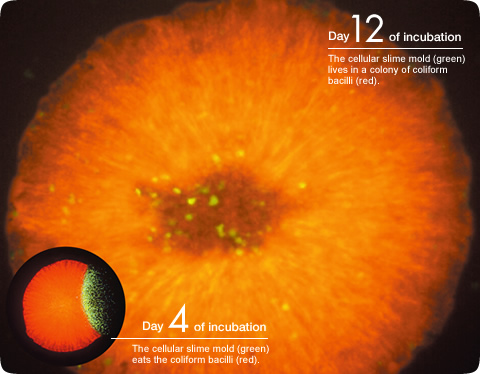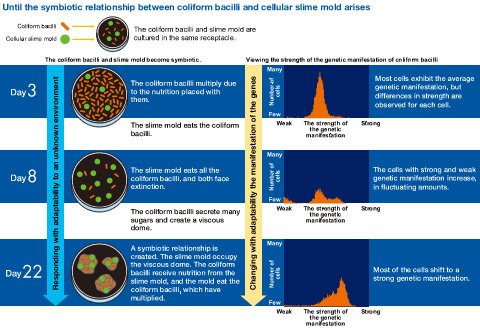Research
The adaptability of living creatures as seen
in the process of symbiotic genesis
When the cellular slime mold that lives in the forest shade is cultured in the same receptacle as the coliform bacilli that are found in the large intestine, the former eats up the latter. They are thus both headed for extinction, but before long, they create a symbiotic colony. Creating a path to symbiosis when confronted by danger is one of the strategies of living organisms that has been maintained for 3.8 billion years.

How does the genetic manifestation for coliform bacilli change during the process of the creation of a symbiotic relationship between them and cellular slime mold? We inserted genes that create fluorescent proteins into the genome and examined the strength of the fluorescence for each cell as an indicator of the strength of genetic manifestation of the coliform bacilli. We observed a large breadth and fluctuation from the weak to the strong in the genetic manifestation. Some cells among the coliform bacilli strongly manifested genes that created fluorescent proteins through this fluctuation before they encountered the slime mold. These increased in number in the process of creating a symbiotic relationship. It is because the coliform bacilli have a fluctuating adaptability in their genetic manifestation to begin with that they can bring about major changes to the state of the cell and create a symbiotic relationship. This is a characteristic of living creatures.
Awarded a doctorate in engineering from the University of Osaka in 1991. After serving as an assistant and an associate professor there, he was named an associate professor in the Graduate School of Information Science and Technology at the same university. He was named a full professor in 2006.
- Dialogue:Theory and observation illuminate the genesis of the universe
Katsuhiko Sato / Keiko Nakamura - Research01:Toward bioplanetary science. Considering life from the origin of planets.
Shigeru Ida - Research02:The adaptability of living creatures as seen in the process of symbiotic genesis
Tetsuya Yomo - Scientist Library:Making discoveries by introducing new methodologies
Shigetada Nakanishi
|
|
